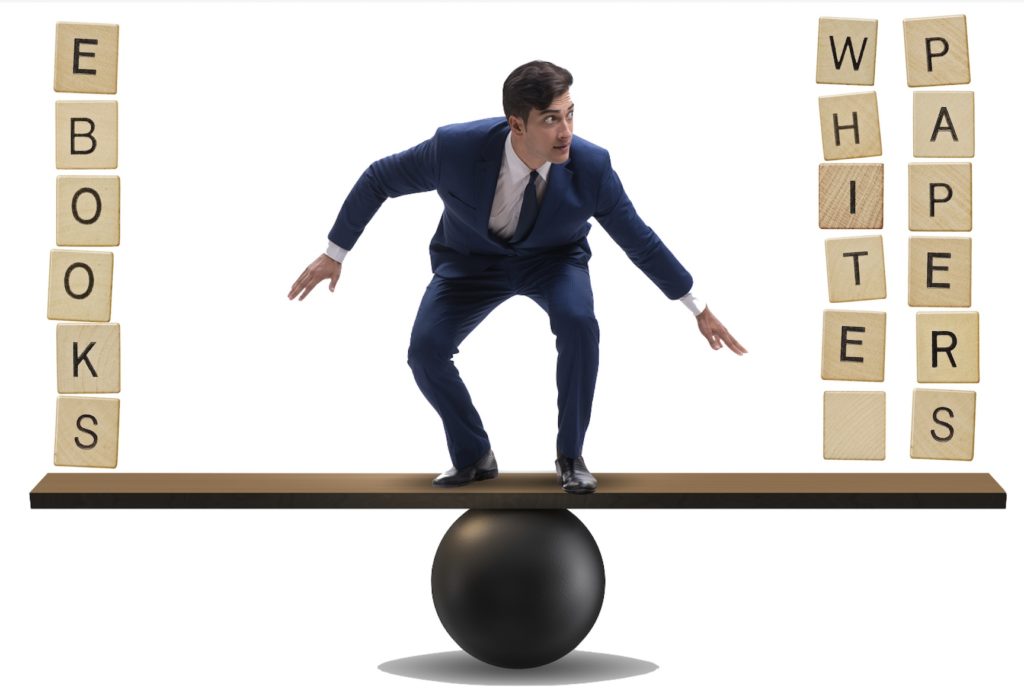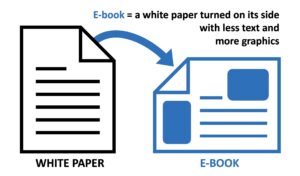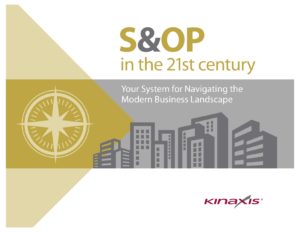
White papers versus e-books
So a client asked me to write an e-book.
Before I started, I searched high and low for guidance on what makes a good e-book:
- How long should it be?
- How many graphics should it contain?
- Landscape or portrait format?
- Any other distinguishing marks?
Unfortunately, I found that an “e-book” can be just about any length on just about any topic.
Remember, we’re not talking about the latest vampire novel for tweens.
We’re talking about B2B e-books published by companies as part of their content marketing efforts.

White papers turned sideways?
There’s no accepted way to tell a white paper and an e-book apart.
Some say e-books are gussied-up white papers turned on their sides, with more graphics and less text.
And I agree that many e-books I see look more like colorful slide decks than in-depth discussions of a topic.
More or less in-depth?
Some say e-books are better for less technical material, or a primer on a topic, while white papers are better for drilling down into more detail.
That’s how these working definitions from content syndicator Netline stack up:
eBooks cover broad topics and ideas and should be educational and easy to digest, used to drive awareness and help buyers find answers, opinions, and insight on a certain topic.
White papers present data, frameworks, and analyses to address complex problems, helping establish authority on a specific subject and are great when buyers require more in-depth, technical information.
Since e-books sound easier to read and feature more graphics, some marketers think e-books work better for B2C. I tend to agree. Consumers don’t usually want to read, they want to shop.
So if you’re selling B2C but you have a big story to tell, consider an e-book before a white paper.
In any case, this table sums up the key differences I can see between a B2B e-book and a white paper.
| E-books | White papers | |
|---|---|---|
| Focus | Generally some topic or problem | Benefits of some product or service |
| Message | Here's a basic intro to this problem | Here's a better way to solve this problem |
| Length | 10 to 200 pages | 5 to 12 pages |
| Format | PDF with good design and many graphics | PDF with good design and a few graphics |
| Lifespan | 1 or 2 years, then refresh | 1 or 2 years, then refresh |
| Time to create | 4 to 12 weeks | 4 to 12 weeks |
| When to use | Early in sales cycle | Early in sales cycle |
| Why to use | To generate leads, engage prospects | To generate leads, engage prospects, explain product or service |
| Analogy | Slide deck | Well-researched essay or article |
When should you use an e-book?
Here are a few scenarios when an e-book might work well.
• White papers are not used in your industry
If no one else in your industry has ever published one, a white paper could sound too strange or too intimidating to download. This applies to all B2C marketing as well. An e-book might be a better choice.
• Your audience is prone to distraction
Your target audience may be younger or often on the road. An e-book may sound like more fun, rather than a white paper that sounds like a lot of work.
• All your competitors already publish white papers
If you’re trying to break through the noise of competing white papers, an e-book might sound different enough to be engaging.
You may gain more traction by presenting the same content as an e-book instead of a white paper.
• You have superior design skills on hand
To make a splash with an e-book, it has to look really good.
Since there are no fixed standards for e-books, there are no formatting conventions to constrain your design.
You can use different backgrounds, wild typefaces, animated graphics, and other visual flourishes that might seem out of place in a more traditional white paper.
See for yourself: Here’s that e-book I wrote
The e-book I wrote ended up being 27 pages, almost 6,000 words. That’s longer than most white papers.
That content was a primer that gave a brief overview of a technical subject.
As for the format, it was turned on its side in landscape mode, like a slide deck. And it was chunked into short sections of one page each.
That e-book had 7 formal footnotes plus 50+ links to further content.
And it offered light-hearted comments in footer that wouldn’t work in a serious white paper.
Producing that e-book was no easier than doing a white paper.
The research and writing were about the same as 1.5 regular white papers, while the design was substantially more effort.
Check it out for yourself: Click the thumbnail above to see the PDF.
Conclusions
Remember: Both an e-book and a white paper have pretty much the same goals.
An effective e-book will help your target audience understand an issue, solve a problem, or make a decision. So will an effective white paper.
If your content does that, you can call it an e-book, a white paper, or whatever… and your audience will thank you for it.
Originally published 2014. Last updated April 5, 2024
What do you think are the main differences between a white paper and an e-book? Please leave us your comment below.
For more useful articles like this, get my free newsletter White Paper World





Hello Gordon,
I was looking for reading a content using paper book vs ebook and found your article. Actually I feel that reading paper book has advantage over ebook but I am not sure if this is scientifically correct. So are there any white papers on this topic? This would be supportive.
[…] to Gordon Graham, also known as That White Paper Guy, e-books are usually anywhere from ten to hundreds of pages, and are best used early in the sales […]